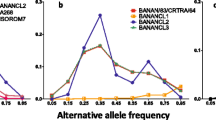Abstract.
In recent years a wide variety of biochemical and molecular typing systems has been employed in the study of parasite diversity aimed at investigating the level of genetic diversity and delineating the relationship between differcnt species and subspecies. However, such methods have failed to differentiate between two of the classically defined subspecies of the protozoan parasite Trypanosoma brucei: the human infective, T. b. rhodesiense, which causes African sleeping sickness, and the non-human infective T. b. brucei. This has led to the hypothesis that T. b. rhodesiense is a host range variant of T. b. brucei. In this paper we test this hypothesis by examining highly polymorphic tandemly repeated regions of the trypanosome genome, i.e., minisatellite loci. We have employed the technique of minisatellite variant repeat mapping by PCR (MVR-PCR), which determines the distribution of variant repeat units along the tandem array of one minisatellite, MS42. The maps generated by this technique not only allow unequivocal allele identification but also contain within them cladistic information which we used to determine the possible genetic relationship between the different subspecies of T. brucei. Our findings revealed that human infective (T. b. rhodesiense) isolates from Uganda are more closely related to the local non-human infective isolates (T. b. brucei) than they are to other human infective stocks from different regions, suggesting that human infectivity has originated independently in these different geographical regions. This would infer that the separate classification of all human infective stocks from East Africa into the subspecies T. b. rhodesiense is genetically inappropriate and it would be better to consider geographically separate populations as host range variants of T. brucei brucei or perhaps as a series of different subspecies. Based on these data, it is clear that MVR mapping is a very useful tool for the analysis of zoonotic eukaryotic pathogens where delineation of the origins of outbreaks of disease and definition of human infective strains are key questions.
Similar content being viewed by others
Author information
Authors and Affiliations
Additional information
Received: 21 June 2000 / Accepted: 25 October 2000
An erratum to this article is available at http://dx.doi.org/10.1007/s00239-002-5402-6.
Rights and permissions
About this article
Cite this article
MacLeod, A., Welburn, S., Maudlin, I. et al. Evidence for Multiple Origins of Human Infectivity in Trypanosoma brucei Revealed by Minisatellite Variant Repeat Mapping. J Mol Evol 52, 290–301 (2001). https://doi.org/10.1007/s002390010157
Issue Date:
DOI: https://doi.org/10.1007/s002390010157




